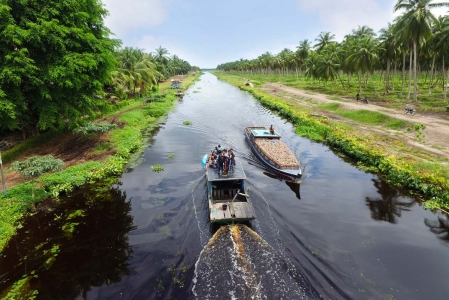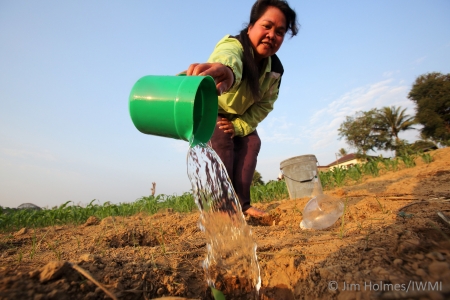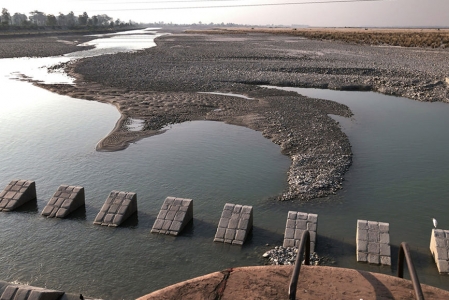Water is key to ensuring food and nutrition security, whether it be for irrigation, livestock, or food processing and transportation. Competition for this essential resource between agricultural, energy, environmental, and municipal uses will increase in lockstep with population growth and societal advancement. Climate change further stresses these competing demands, causing floods in some regions and droughts in others. These interacting stresses on water availability throw a real challenge at agricultural development.
As experts at the recent IFPRI symposium Addressing Water Variability and Scarcity – The Role of Agricultural Research, we outlined how reliable access to water influences agricultural development and food security in many ways. Expanding agricultural production in developing countries would reduce poverty while increasing food security. Improvements to nutrition can be achieved through increased production, and particularly through producing better quality, more nutrient-dense foods, such as fruits, vegetables, and livestock products. Since irrigated agriculture is two times more productive than rain-fed agriculture, adding irrigation can increase food and fiber production and farm income.
While agriculture remains an economic driver in many rural regions, half of the world’s population resides in urban areas, where people can be disconnected from rural issues and food production. This shift also causes agriculture to compete with increasing municipal and industrial demands for water---not preparing for competing water demands will have an enormous economic impact on the viability of rural communities and agricultural producers.
Agricultural research continues to improve food and fiber production, and has been a key driver for changes in agricultural water use. From low-tech, gravity-fed drip irrigation for smallholder farmers to high-tech operations involving precision irrigation, better water management is a further approach to increasing production while conserving water. However, low adoption of irrigation technologies in developing countries is a challenge. Irrigation, especially for smallholder farmers with limited resources, requires capital for the purchase and maintenance of equipment.
One way to address this challenge is through incentives. A California grant program to support upgrading farm irrigation systems led to the adoption of water-saving technologies across the state, showing that this approach can have an impact on decision-making irrespective of farm size. Advanced irrigation technologies need, furthermore, be paired with institutions that ensure that water resources are available for all key water uses.
Innovative solutions are also needed to give smallholder farmers access to financing for irrigation technologies, as well as to reduce the risk for entrepreneurs importing these technologies into developing countries. Providing education so farmers can fully benefit from new irrigation technologies will also play a part in any successful program.
Improving crops is another way to reduce water usage. Crop breeding has moved into coupling genomic sequences with cutting-edge phenotyping platforms, utilizing technologies such as UAVs (Unmanned Aerial Vehicles) and computational systems, where sensors and imaging platforms are integrated with artificial intelligence to generate terabytes of data a day.
These technological advancements allow breeders to find genes related to water efficiency to produce crops that require less water and are tolerant to flooding or drought. Combining improved genetics with better management practices in the field remains one of the most powerful tools for increasing water use efficiency.
Food security remains a key challenge for a growing and thriving population and water is essential to producing food. However, water use decisions are not as simple as turning on a tap. Policies, water rights, markets, and exports all impact irrigation. Adding irrigation is not a simple solution, as water resources are limited in many regions resulting in competition for the resource among multiple entities. Policies should encourage adoption of better technology, allow for flexibility in accessing and using water, such as through water trading, and consider markets to facilitate access to water and complementary resources.
Improving water use in agriculture is a complex problem, but great strides can be made by combining new technologies with supportive policies.
Also published on FutureEarth
-----
This blog is based on a scientific symposium Addressing Water Variability and Scarcity – The Role of Agricultural Research co-organized by WLE partners International Food Policy Research Institute (IFPRI) and the ILSI Research Foundation on July 17, 2019 at IFPRI in Washington, DC. The symposium brought experts together to discuss how agricultural research could improve production while also conserving water resources. Speakers included Dr. Claudia Ringler (IFPRI), Dr. Morven McLean (ILSI Research Foundation), Dr. Mark Rosegrant (IFPRI), Dr. Biniam Iyob (USAID), Dr. David Schimmelpfennig (USDA Economic Research Service), Dr. Todd Mockler (Donald Danforth Plant Science Center), Dr. Mutsa Masiyandima (World Bank), Dr. Mark Giordano (Georgetown University), and Dr. Josette Lewis (Almond Board of California). Their presentations were followed by a panel discussion.
















Comments
The solution are the use of small scale irrigation technologies likly the california irrigation system used under solar pump (Success story in Mali at IER research Institute of Sotuba).
Dear Kane Abdoulah Mamary, We would be very interested to hear about your success story in Mali. Under the USAID supported Small-scale irrigation innovation lab we are looking into how to remove constraints to small-scale irrigation development in Mali. Please get in contact! Regards, Claudia